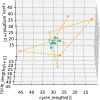Characterizing physiological and symptomatic variation in menstrual cycles using self-tracked mobile-health data
- PMID: 32509976
- PMCID: PMC7250828
- DOI: 10.1038/s41746-020-0269-8
Characterizing physiological and symptomatic variation in menstrual cycles using self-tracked mobile-health data
Abstract
The menstrual cycle is a key indicator of overall health for women of reproductive age. Previously, menstruation was primarily studied through survey results; however, as menstrual tracking mobile apps become more widely adopted, they provide an increasingly large, content-rich source of menstrual health experiences and behaviors over time. By exploring a database of user-tracked observations from the Clue app by BioWink GmbH of over 378,000 users and 4.9 million natural cycles, we show that self-reported menstrual tracker data can reveal statistically significant relationships between per-person cycle length variability and self-reported qualitative symptoms. A concern for self-tracked data is that they reflect not only physiological behaviors, but also the engagement dynamics of app users. To mitigate such potential artifacts, we develop a procedure to exclude cycles lacking user engagement, thereby allowing us to better distinguish true menstrual patterns from tracking anomalies. We uncover that women located at different ends of the menstrual variability spectrum, based on the consistency of their cycle length statistics, exhibit statistically significant differences in their cycle characteristics and symptom tracking patterns. We also find that cycle and period length statistics are stationary over the app usage timeline across the variability spectrum. The symptoms that we identify as showing statistically significant association with timing data can be useful to clinicians and users for predicting cycle variability from symptoms, or as potential health indicators for conditions like endometriosis. Our findings showcase the potential of longitudinal, high-resolution self-tracked data to improve understanding of menstruation and women's health as a whole.
Keywords: Data mining; Data processing.
© The Author(s) 2020.
Conflict of interest statement
Competing interestsK.L. is supported by NSF’s Graduate Research Fellowship Program Award #1644869. I.U., C.H.W., and N.E. are supported by NSF Award #1344668. K.L., I.U., C.W., and N.E. declare that they have no competing interests. A.D., A.S., and V.J.V. were employed by Clue by BioWink GmbH at the time of this research project.
Figures










Similar articles
-
A predictive model for next cycle start date that accounts for adherence in menstrual self-tracking.J Am Med Inform Assoc. 2021 Dec 28;29(1):3-11. doi: 10.1093/jamia/ocab182. J Am Med Inform Assoc. 2021. PMID: 34534312 Free PMC article.
-
More than blood: app-tracking reveals variability in heavy menstrual bleeding construct.BMC Womens Health. 2023 Apr 11;23(1):170. doi: 10.1186/s12905-023-02312-4. BMC Womens Health. 2023. PMID: 37041503 Free PMC article.
-
Evaluation of Menstrual Cycle Tracking Behaviors in the Ovulation and Menstruation Health Pilot Study: Cross-Sectional Study.J Med Internet Res. 2023 Oct 27;25:e42164. doi: 10.2196/42164. J Med Internet Res. 2023. PMID: 37889545 Free PMC article.
-
Menstrual Tracking Mobile App Review by Consumers and Health Care Providers: Quality Evaluations Study.JMIR Mhealth Uhealth. 2023 Mar 1;11:e40921. doi: 10.2196/40921. JMIR Mhealth Uhealth. 2023. PMID: 36857125 Free PMC article. Review.
-
Epidemiology of menstruation and its relevance to women's health.Epidemiol Rev. 1995;17(2):265-86. doi: 10.1093/oxfordjournals.epirev.a036193. Epidemiol Rev. 1995. PMID: 8654511 Review.
Cited by
-
COVID-19 vaccination and changes in the menstrual cycle among vaccinated persons.Fertil Steril. 2023 Mar;119(3):392-400. doi: 10.1016/j.fertnstert.2022.12.023. Epub 2022 Dec 17. Fertil Steril. 2023. PMID: 36539055 Free PMC article.
-
Menstrual irregularity as a biological limit to early pregnancy awareness.Proc Natl Acad Sci U S A. 2022 Jan 4;119(1):e2113762118. doi: 10.1073/pnas.2113762118. Proc Natl Acad Sci U S A. 2022. PMID: 34969843 Free PMC article.
-
The messiness of the menstruator: assessing personas and functionalities of menstrual tracking apps.J Am Med Inform Assoc. 2022 Jan 12;29(2):385-399. doi: 10.1093/jamia/ocab212. J Am Med Inform Assoc. 2022. PMID: 34613388 Free PMC article. Review.
-
The Politics, Promises, and Perils of Data: Evidence-Driven Policy and Practice for Menstrual Health.Womens Reprod Health (Phila). 2020;7(4):227-243. doi: 10.1080/23293691.2020.1820240. Epub 2020 Oct 6. Womens Reprod Health (Phila). 2020. PMID: 36199294 Free PMC article.
-
Good-Quality mHealth Apps for Endometriosis Care: Systematic Search.J Med Internet Res. 2025 Feb 7;27:e49654. doi: 10.2196/49654. J Med Internet Res. 2025. PMID: 39918848 Free PMC article.
References
-
- Bedford JL, Prior JC, Barr SI. A prospective exploration of cognitive dietary restraint, subclinical ovulatory disturbances, cortisol, and change in bone density over two years in healthy young women. J. Clin. Endocrinol. Metab. 2010;95:3291–3299. - PubMed
-
- Zittermann A, et al. Physiologic fluctuations of serum estradiol levels influence biochemical markers of bone resorption in young women. J. Clin. Endocrinol. Metab. 2000;85:95–101. - PubMed
-
- Solomon CG, et al. Menstrual cycle irregularity and risk for future cardiovascular disease. J. Clin. Endocrinol. Metab. 2002;87:2013–2017. - PubMed
-
- Carmina E, Lobo RA. Polycystic ovary syndrome (PCOS): arguably the most common endocrinopathy is associated with significant morbidity in women. J. Clin. Endocrinol. Metab. 1999;84:1897–1899. - PubMed
Grants and funding
LinkOut - more resources
Full Text Sources
Medical

